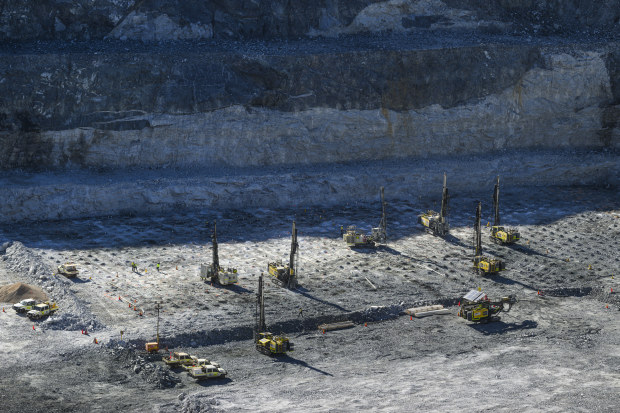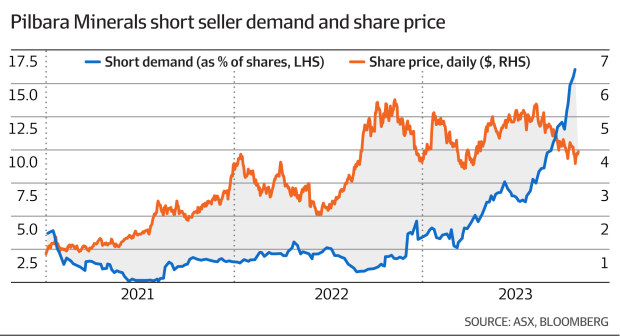Lithium is hot. So why are short-sellers targeting Pilbara Minerals?
Demand for the key batteries component has never been higher, but one of the country’s largest producers has become the most-bet-against stock on the market.
Elouise FowlerOct 29, 2023 – 4.00pm
Bulls & bears
Reporter
Pilbara Minerals operates the largest hard rock lithium mine in the country. New York Timesnone
While on the hunt for Liontown shares, Rinehart was also secretly building an 18 per cent stake in Azure Minerals, which places her in the box seat to decide the fate of a $1.63 billion takeover offer for the lithium explorer from Chilean company Sociedad Química y Minera.
But as mining tycoons and foreign companies limber up to consolidate and acquire scarce lithium projects in Australia, Pilbara Minerals – which owns one of the largest hard rock lithium mines in the country – has become the most shorted company on the local sharemarket. In the 12 months to October, short-sellers have positions on 16 per cent of all Pilbara shares, compared with just 1 per cent in the previous year, according to ASX data.
“It’s a curious time,” says David Franklyn, head of Argonaut, a resources fund that holds stock in Pilbara. “The billionaires and short-sellers are operating in different contexts and time frames.”
The billionaires are playing the long game, betting demand for lithium will explode as the clean energy transition picks up, while the short-sellers expect Pilbara’s share price will decline amid weak near-term conditions, he says. “Rinehart and Mineral Resources are in a land grab for tier one assets, in a tier one location, and there are not many projects around.
“They’re trying to at least have an influence, but ideally get control of, these tier one assets. The reason for this is if you stand back and look at the market, it’s still pretty small, and it’s in the very early stages of a massive expansion.”
The billionaires are banking on a bright outlook for the commodity. Lithium prices soared to record levels in the past three years as carbon-conscious government stimulus underwrote strong demand for the lithium-ion batteries that power electric vehicles.
That price boom put a rocket under Pilbara, which owns the Pilgangoora mine. It posted a record net profit of $2.4 billion for the last financial year when it received an average price of $US4447 a tonne for lithium-rich spodumene concentrate.
Since January, however, short-term prices for spodumene, Australia’s sixth-largest export, have plunged 63 per cent from $US6000 per tonne to $US2200 per tonne, largely due to fewer Chinese customers buying electric vehicles.
Today’s price is still around twice as much as lithium procurers were collecting in the first lithium boom which ended in 2018, but Franklyn said the price drop helps to explain the short-seller campaign against Pilbara.
Short campaign
Short selling is an investment strategy by which an investor borrows shares from long-term holders with the expectation the share price will decline. The short-seller then repurchases the stock at a lower price. Once the stock is repurchased, the stock is delivered back to its owner – who earns a fee for loaning out their stock – and the short-seller pockets the profit.
Despite the price of lithium tanking over the past year, Pilbara’s share price has lifted 8 per cent since December 31, closing at $3.92 on Friday. Over the same time, short positions held by investors have swelled from 3.4 per cent to 16 per cent through to October 23, according to data compiled by the ASX.
“The short-sellers are saying we need the market to re-evaluate,” Argonaut’s Franklyn said. “The short-sellers are factoring in a decline in profit this year due to lower spodumene prices, a capital expenditure program bringing Pilbara’s cash on hand down, and in the short term it doesn’t have the growth profile that the market likes.”
Pilbara Minerals is the most shorted stock on the ASX. AFRnone
On Thursday, Pilbara reported revenue of $493.1 million in the three months to September 30, down from $868 million in the June quarter. The fall reflected a 31 per cent slide in the price received for its spodumene concentrate to $US2240 ($3552) a tonne and lower production. Operating costs jumped 19 per cent to $747 a tonne as the company pushed ahead with a major expansion at Pilgangoora.
In response to analyst questions on the September quarter call, Pilbara chief executive Dale Henderson said the congregation of short-sellers reflected investor desire to hedge against lithium prices, rather than Pilbara’s outlook.
“There appears to be a component of the market that wants to short lithium pricing and given that there’s no available mechanism to do that, they have gravitated, it would appear, to Pilbara as a proxy for the lithium market because of our scale, pure play exposure and our liquidity,” he said on the call last week.
Still, following the September quarter results, at least three investment banks have cut their share price forecasts for Pilbara. Goldman Sachs reduced its outlook to neutral and cut the target price by 7.3 per cent $3.80. UBS retained its neutral rating and $4.15 price target as did Barrenjoey, which has a $4.20 price target.
Bullish analysts such as Euroz Hartleys have kept a buy rating but cut the target price by 9.9 per cent $5.10 per share. Canaccord Genuity has also kept a buy rating, slightly reducing its price target by 10¢ to $5. Macquarie’s analysts were outliers, keeping its share price target at $7.10.
“There’s a lot to like about Pilbara. We see it as a growth opportunity,” Franklyn said. “We don’t see much of a downside risk apart from the lithium price, and what’s good about it is it has growth potential and 100 per cent ownership, unlike Mineral Resources and Liontown.
“But there needs to be a reassessment of it on what is more likely to happen going forwards where a price of $4000 per tonne or $5000 per tonne is not sustainable,” he adds. “It’s very hard to beat last year’s profit.”
- Forums
- ASX - By Stock
- Good News & Bad News
Lithium is hot. So why are short-sellers targeting Pilbara...
-
- There are more pages in this discussion • 12,687 more messages in this thread...
You’re viewing a single post only. To view the entire thread just sign in or Join Now (FREE)
Featured News
Add PLS (ASX) to my watchlist
 (20min delay) (20min delay)
|
|||||
|
Last
$3.13 |
Change
0.170(5.74%) |
Mkt cap ! $9.425B | |||
| Open | High | Low | Value | Volume |
| $3.05 | $3.14 | $3.01 | $78.76M | 25.44M |
Buyers (Bids)
| No. | Vol. | Price($) |
|---|---|---|
| 2 | 1050 | $3.12 |
Sellers (Offers)
| Price($) | Vol. | No. |
|---|---|---|
| $3.14 | 385402 | 22 |
View Market Depth
| No. | Vol. | Price($) |
|---|---|---|
| 2 | 1050 | 3.120 |
| 2 | 14848 | 3.110 |
| 12 | 255876 | 3.100 |
| 15 | 1471406 | 3.080 |
| 5 | 153212 | 3.070 |
| Price($) | Vol. | No. |
|---|---|---|
| 3.140 | 338319 | 20 |
| 3.150 | 546670 | 74 |
| 3.160 | 137443 | 15 |
| 3.170 | 26176 | 10 |
| 3.180 | 123346 | 17 |
| Last trade - 16.10pm 12/11/2024 (20 minute delay) ? |
Featured News
| PLS (ASX) Chart |
The Watchlist
NUZ
NEURIZON THERAPEUTICS LIMITED
Michael Thurn, CEO & MD
Michael Thurn
CEO & MD
SPONSORED BY The Market Online







